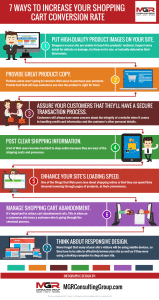In this technologically advanced day and age, you are no longer required to go through the lengthy process of securing a physical location to use as a store for the products you mean to sell.
Everything can be done on a laptop with a steady Internet connection — and that includes promoting your brand, attracting potential clients, sharing information about your merchandise, guiding your customers through transactions, and facilitating payment and delivery processes that guarantee your customers’ satisfaction.
Of course, if you wish to maintain a highly successful online store, you have to actively put effort into executing effective strategies that would increase your shopping cart conversion rate. There is always a chance that Web users who find their way into your online store, and have already begun their shopping process, will abruptly cancel the transaction and leave your website for one reason or another. So your goal must be to encourage online shoppers to see the transactions through to completion, for your mutual benefit.
For example, nobody likes a slow checkout process. Consider these numbers:
- During checkout, 57% of customers wait 3 seconds before abandoning a site.
- 80% of them never return.
For that reason, a lot of small businesses have realized that joining Amazon’s FBA program (Fulfilled by Amazon) makes it fast, easy, and safe for their customers to complete their purchases. With just a few clicks or taps from any device, they can quickly purchase your products using information already stored in their Amazon accounts. Fewer steps for your customers means a higher conversion rate for you.
If you’re not ready yet to have your products for sale on Amazon’s store, below are seven simple ways to improve shopping cart conversion on your own e-commerce store.
- Put high-quality product images on your site. Shoppers on your site are unable to touch the products’ material, inspect every detail for defects or damage, try them on for size, or instantly determine their dimensions. As such, you need to post photos that will help them visualize the item as best as they can. Provide photos from different angles and in different colors, and include the ability to zoom.
- Provide great product copy. Pictures alone aren’t going to convince Web users to purchase your products. Provide text that will help customers see how the product is right for them. Offer a brief copy that describes what the product is, what it does, whom it’s for, and why it’s the best option out there. You can also provide a longer copy version that can help answer any other questions about it that customers may have.
- Assure your customers that they’ll have a secure transaction process. Customers will always have some concern about the integrity of a website when it comes to handling credit card information and the customer’s other personal details. Have a well-known payment service integrated into your site, like Master Card or Pay Pal, and include credibility boosting logos and tags in your shopping cart (ones that guarantee that your website is equipped with antivirus software and secure transaction systems, for example).
- Post clear shipping information. A lot of Web users become hesitant to shop online because they are wary of the shipping costs and processes. Be sure to clearly indicate what shipping fees and times can be expected so that they can properly decide if buying something online is more favorable than getting it from a physical store.
- Enhance your site’s loading speed. One of the things that Web users love about shopping online is that they can spend time leisurely browsing through pages of products, at their convenience. But no customer will have the patience to wait for slow loading pages when they can skip off to other faster e-commerce sites. It’s critical to improve page speed — it should not take more than three seconds to display a page — to help improve your customers’ user experience.
- Manage shopping cart abandonment. It’s important to reduce cart abandonment rate. This is when an e-commerce site loses a customer who is going through the checkout process — the customer chooses to leave the transaction unfinished, which means lost sales for the business. High prices, shipping costs, unaddressed customer inquiries, lengthy registration processes (that request too much information) and slow websites are some of the top reasons why Web users abandon their shopping carts. You can address this by following up with customers through email to retarget shoppers and gather information that can help you reassess and improve your website.
- Think about responsive design. Never forget that many of your site’s visitors will be using mobile devices, so they have to be able to effectively browse your site as well as if they were using a desktop computer to shop at your site. The mobile market is significant, and all business owners would benefit much from catering to their needs.
Our Team at MGR has ample experience setting up Amazon stores for some of our clients. Whether you just want to sell a single product or an entire product line, we have created flexible programs so you too can benefit from your own Amazon store without any delays.
If you have a product or products to sell and want to expand your customer base into Amazon’s nationwide reach, feel free to contact us and we will find and set up your Amazon store from start to finish so you can simply sit back, relax, and collect your revenue check each month. Click Here to Learn More >
Thank you for reading. Until next time, this is Manuel Gil del Real (MGR)






